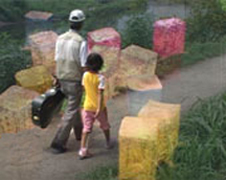Making "Hibakusha, Our Life to Live."
Making the film came from a lifetime of childhood, young adult, military and artistic growth and experiences. As a child growing up during WWII the war was my fantasy battleground. I learned it all through Hollywood movies, radio plays, newsreels, victory gardens, gas coupons, margarine, air raid drills and bringing cooking grease to the butcher and metal to the community wire basket. But Hollywood movies were my primary educational resource.
By the time of the Atom bomb I had learned every statistic about enemy uniforms, guns, planes and ships. I even bought a war bond with meager savings and signed my name to a bomb that would be dropped on enemy troops or civilians. Revenge and victory were our motives. Some time before the atomic bombs were dropped there were rumors that either England or the U.S. was making a bomb that would destroy a whole city. The idea was intriguing to our impressionable minds. Vaporize everything in one blazing instant. We celebrated like mad when the bombs were dropped on Hiroshima and Nagasaki. Atomic rings became the rage. Send one cereal box-top and twenty-five cents. The ring was magical. You would shake it up, take it into a dark closet and watch the depleted uranium spin in space. Awesome! But I wanted my own bomb. So I stole my Mother's atomizer, filled it with wooden match heads, compressed the lot and ignited the "bomb." It went "poof!" a cloud of smoke choked out of the atomizer and that was it.
My political consciousness went from fantasy to reality during two years in the army when I learned to question authority. In 1967 I read John Hersey's book, "Hiroshima." It was then that I learned of the genetic effects upon children caused by radiation from the Atomic bomb. My world had changed. A psychological terror hung over our heads. The invention of nuclear weapons meant that our survival was at stake. What kind of future would our children have and their children? Would there be a future at all, or were we doomed to nuclear annihilation? These questions haunted me until in 2003 I was introduced to two hibakusha, one from Hiroshima and one from Nagasaki. I interviewed them. Their stories and the music of Eiji Nakanishi touched me. One year later I interviewed two more hibakusha. Then in 2005 four more came to Boston. I knew then I would make a film. That summer I traveled to Japan to start filming stories of hibakusha from Japan, Korea and the USA. Japanese people opened their homes and hearts to me.
Their help and encouragement inspired me to film for three years.
Back in America, good will and support continued. The making of the film was as if a vortex had formed that united people from different cultures and geographical locations. It was a good prescription for world peace.
Finally in May of 2010 we completed post-production of "Hibakusha, Our Life to Live."
Memory Productions • 90 Boylston Street #1 • Chestnut Hill, MA 02467 • 617 332-5014
Site design by June Santosa
